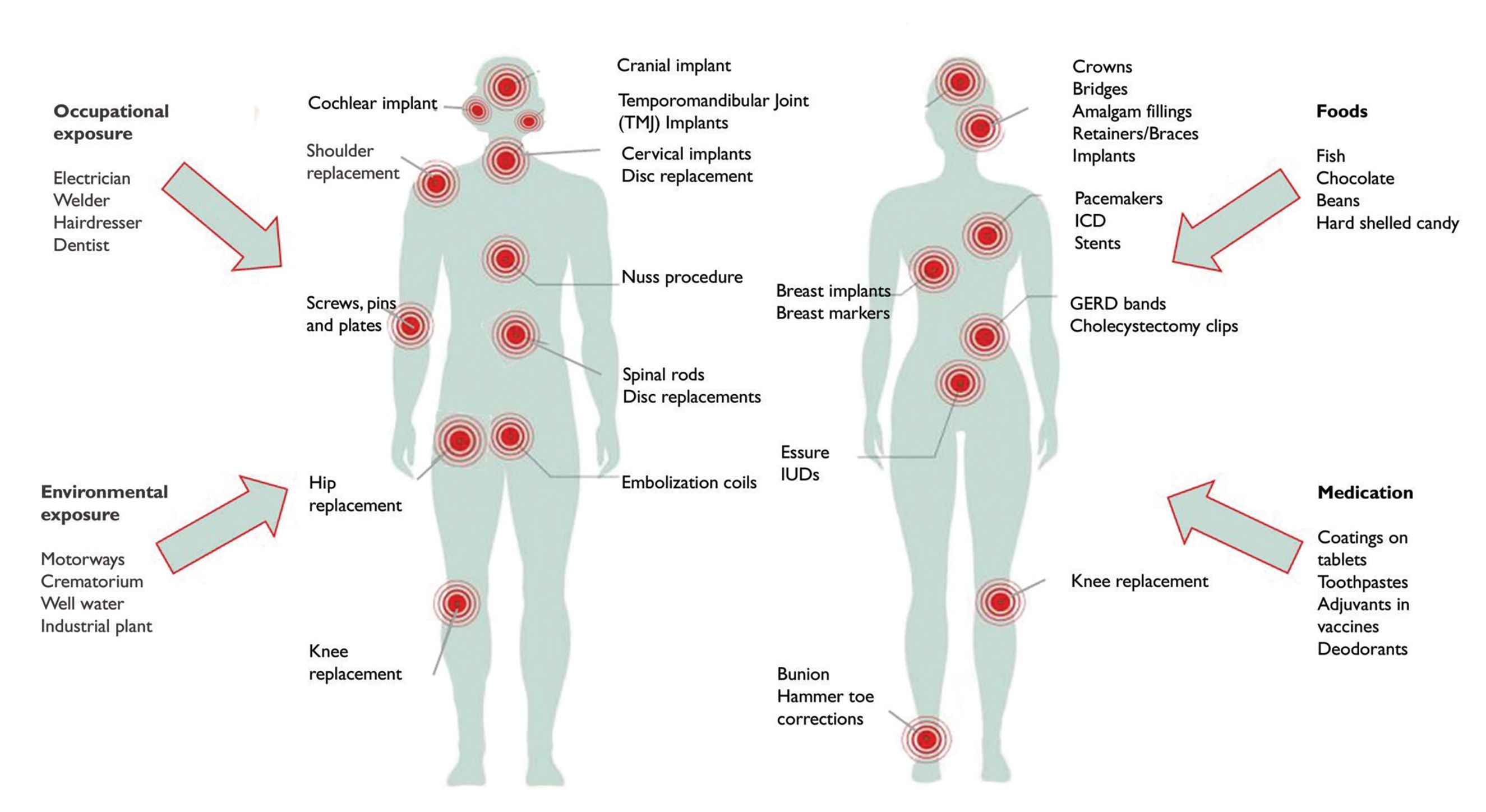
Metal exposure
The testing panels offered by MELISA laboratories have been devised to include the most commonly found allergy-causing metals in various metal alloys used in dentistry and surgery. Below you will find an overview of metals found in frequently used dental and orthopaedic restorations as well as an overview of metals present in our environment.
Laboratories offer different testing panels to help doctors and patients choose what to test. Typically, the choice of panels for testing will be based on the patient’s current exposure. Patients should contact their health care provider to find out the exact composition of their fillings, crowns, wires, pins and/or implants.
Common sources of metal exposure

Dental restorations
Various materials are used to manufacture fillings, crowns, pins, root-fillings, implants etc. Below are listed metals commonly present in dental restorations. Information about the exact type of restoration used should be included in the patient’s medical record.
Amalgam/silver fillings: copper, mercury, nickel, silver, tin
Crowns non noble: beryllium, cobalt, chromium, manganese, molybdenum, nickel, tungsten
Crowns noble: gallium, gold, indium, iridium, palladium, platinum, ruthenium, silver
Titanium implants: aluminium, titanium, vanadium, nickel (traces)

Orthopedic and body implants
Various alloys are used to manufacture hip and knee replacements, spinal implants, plates, screws, nails, pins, clips etc. Below are listed commonly used alloys and their typical compositions. Information about the exact type of implant used during surgery should be included in the patient’s medical record.
Stainless steel: chromium, manganese, molybdenum, nickel, tungsten
Cobalt-Chromium alloys: cobalt, chromium, manganese, molybdenum, nickel, tungsten
Titanium (Ti-6Al-4V): aluminium, titanium, vanadium, nickel (traces)
Nitinol: nickel, titanium
Oxinium: niobium, zirconium (oxidized), chromium (traces), tin (traces)

Food
Foods from contaminated areas may contain more metals than others, whether fish, meat, vegetables or fruit.
Fish can contain high amounts of methyl mercury, which accumulates up in the food chain so that large predatory fish contain more mercury than smaller fish.
Seafood may contain mercury, cadmium and arsenic.
Vegetables from polluted areas may contain cadmium, palladium, lead etc.
Tinned food can contain tin and aluminium.
Wine can contain molybdenum, nickel and lead.
Nickel is found in bananas, cocoa, oatmeal, green vegetables and a variety of other foods, more details can be found HERE

Cosmetics
Titanium dioxide is widely used in cosmetics, present in many products such as eye shadow, blush, nail polish, lotion, lipstick, powder and sunscreen. Metal pigments are used to give colour and act as preservatives. The following metals may exist in cosmetic products: lead, mercury, chromium, aluminium, arsenic, beryllium, nickel, cadmium and others.

Medication
Antacids contain aluminium and pills may have titanium dioxide (E171) or other metal oxides in their coating to enhance their appearance. Antiseptic preparations used to contain mercury and still do in some countries. Barium is found in x-ray fluids.

Vaccines
May contain thimerosal (a mercury-based preservative) and aluminium.

Smoking
Both active and passive smoking contain mercury, nickel, cadmium and, manganese.

Piercings and jewellery
Costume jewellery may contain a lot of different metals, most notably nickel, which often cause skin rashes in sensitive patienys. Lead may also be present.
In more expensive jewelry, yellow gold is made by mixing pure gold with copper and zinc; rose gold contains copper and white gold is an alloy of gold and some white metals such as silver and palladium. Other metals used in jewelry are platinum, rhodium, tungsten and titanium. Titanium is often used for piercings and there are some rare cases of allergy to titanium alloy piercings.

Occupational exposure
Construction workers, miners, electricians, rubber/wood/paper/textile industry workers, dentists, hairdressers and painters are some occupations that are more exposed to metals in their work than others.

Residential exposure
Living close to a highway, airport, crematory or factory or, for example, in the same building as a dental clinic may lead to increased exposure to metals such as palladium, cadmium, lead and mercury.
